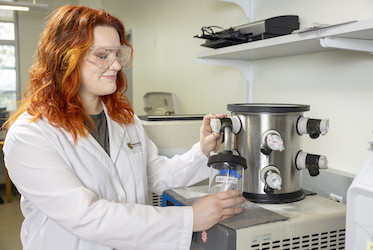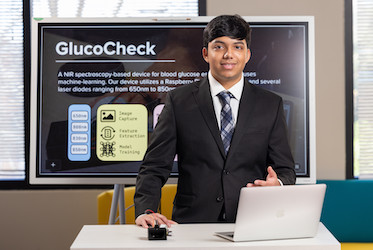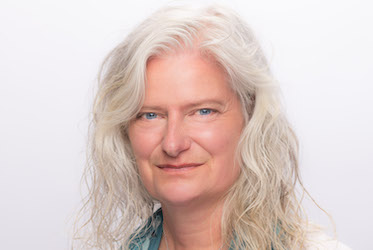
High Touch/High Tech for Sustainability
KENNESAW, Ga. | Apr 17, 2017
Students use different approaches to increase awareness
Christine Rubel and Hannah Knab share a passion for the issue of sustainability. But they each bring entirely different skill sets to the multifaceted task of raising the campus community’s awareness about it.
For Rubel, a recently graduated theater major with a minor in environmental studies, old-fashioned, hands-on, build-from-the ground-up organizing and shoe leather works. At least it has for the Green Ambassadors, an organization she founded in fall 2016 and left positioned for growth when she graduated in December.
Knab, a geography major with a certificate in geographic information science (GIS), used the latest tools of her science to literally put Kennesaw State’s entire sustainability profile on the map. The KSU Sustainability Web Map she created uses a series of tabs and icons to depict all the sustainability features the University has established on its way to a goal of zero greenhouse emissions by 2064.
For both, sustainability has been elevated from cause célèbre to raison d’étre. They envision themselves working in meaningful ways to make sustainability a part of the fabric of life – the way things are done – at KSU and beyond.

Building an awareness infrastructure
Rubel says she experienced “an epiphany” when she took a sustainability course taught by R.C. Paul, Kennesaw State’s director of sustainability and biology professor.
“That’s when I knew I had to get involved and do something,” said Rubel, who just started a part-time position with Collective Wisdom Group, a sustainability consulting firm in Atlanta. “Dr. Paul connected all the dots with his approach to teaching that sustainability was not just about the environment, it was about everything – people, planet and profits.”
Rubel began as a committee of one, creating and making presentations to classes, taking informal surveys, doing campus sustainability tours, all the while recruiting people who shared her passion and vision. By the end of the fall semester, she estimates that she provided sustainability education to more than 600 people and trained a new cohort of Green Ambassadors to join her in tabling at weekly farmer’s markets and other campus events. She said she feels very optimistic about the future of the Green Ambassadors because she has been deliberate in building the organization and training those who will carry on.

“We’ve worked to create a long-term structure that consists of a diverse group of people,” said Rubel, who receives the R.C. Paul Excellence in Sustainability Award this week. “We worked to train Ambassadors on how to explain sustainability; why it matters and all the things KSU is doing in sustainability.”
After graduation, Rubel continued training new members on how to present the information.
“Everybody can do their part, no matter what their major, skill or career goal is,” she said. “There’s a huge job market out there. If you’re hoping to be an accountant, why not work for a solar energy company rather that a plastics company?”
Telling the sustainability story
The opportunity to use GIS mapping to plot the University’s sustainability features and points of interest fell into Hannah Knab’s lap when a fellow student passed it off, knowing she would not have sufficient time to do a good job.
Knab took on the project and has spent a little more than a year – through introductory and advanced GIS class projects and a paid internship – completing the mapping of the Kennesaw and Marietta campuses. In the process, she has received guidance and support from her Green Ambassador mentor, Christine Rubel; Jennifer Wilson, sustainability program support coordinator in the Office of the Vice President of Facilities; and Vanessa Slinger-Friedman, associate professor of geography.
“I’ve worked closely with Christine and the Green Ambassadors and learned a lot about sustainability from Ms. Wilson,” said Hannah, who put all she learned into the mapping project. She painstakingly created the map using a GIS software program called ARC Map, and was in the first GIS class to learn how to take the maps from ARC and put them online, she noted.
Knab’s map now stands as a visual representation of Kennesaw State’s commitment and progress since 2007 when the University signed onto the American College and University Presidents Climate Commitment, now part of the Second Nature Carbon Commitment. Its tabs and icons highlight and locate LEED-certified green buildings, green farming and dining, bike paths and alternative transportation routes, including bus routes, access to Zip Cars, bike repairs and showers for those who may want to freshen up after bike rides to work or throughout the work day.

The map also pinpoints the locations of sustainability education classes and organizations students may join to be more involved with sustainability. Icons also indicate utility efficiency facts related to water use and the handling of rainwater, and a utility dashboard to view gas, water and electricity usage for 27 different campus buildings. Clicking on the icons activates drop-downs that give more detailed information.
“This was a very important project that is very valuable because it shows how hard KSU has tried to achieve sustainability and how much [the institution] cares about this issue,” Knab said. “I think actually seeing all of this on a map makes you really appreciate the hard work and commitment to sustainability. I hope the University continues to do more. I don’t want this work to ever be forgotten.”
Paul, who will soon retire as Kennesaw State’s sustainability director and professor, praised Rubel’s and Knab’s contributions, suggesting they will have a lasting impact at KSU.

“Both Chrissy and Hannah have done great things for KSU and sustainability,” he said. “Hannah's sustainability maps are receiving a lot of interest from other universities and colleges that have seen them. Chrissy revived an on-campus sustainability-focused student group ("EcoOwls") and launched the Green Ambassadors program, which will be a tremendous asset for raising awareness about our sustainability efforts. The enthusiasm with which both of these students have taken on these roles is especially impressive.”
Like Rubel, the mapping project and work with the Green Ambassadors have helped steer Knab towards a career in sustainability. She will graduate in May, and is now interning in the City of Atlanta’s Office of Sustainability, where she is working on a project to turn a blighted urban neighborhood into a sustainable food forest.
“There’s a lot you can do with GIS skills, but I want to stay in sustainability for a while,” she said.
– Sabbaye McGriff
Photo by David Caselli
Related Stories

From the salon to the lab, chemistry student shines at Kennesaw State

Freshman Kennesaw State student has unprecedented success in research

Academic leader, researcher named dean of Kennesaw State's College of Science and Mathematics

Kennesaw State University to offer Master of Science in Artificial Intelligence
A leader in innovative teaching and learning, Kennesaw State University offers undergraduate, graduate and doctoral degrees to its more than 45,000 students. Kennesaw State is a member of the University System of Georgia with 11 academic colleges. The university’s vibrant campus culture, diverse population, strong global ties and entrepreneurial spirit draw students from throughout the country and the world. Kennesaw State is a Carnegie-designated doctoral research institution (R2), placing it among an elite group of only 7 percent of U.S. colleges and universities with an R1 or R2 status. For more information, visit kennesaw.edu.















